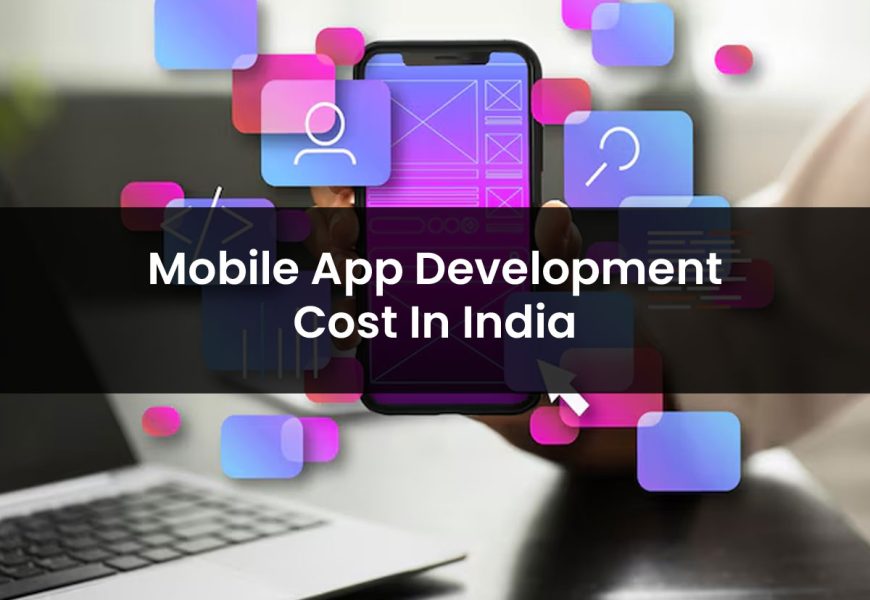The world today is digital and when one says that there is an app for everything, you better believe it to be true.
The rise of app development trends has been nothing short of a revolution, with mobile and web apps gaining unprecedented popularity. Both the Play Store and App Store recently marked their 12th anniversary, and the growth in the number of apps shows no signs of slowing down. Despite the staggering 35-36 billion app downloads from Google Play and the Apple App Store combined, there is still ample opportunity for new apps to enter the market. This opens the door for companies to create innovative apps that transform the way people engage with your business, appealing to Boomers, Millennials, and Gen Z alike.
However, this surge in app development also raises a crucial question that has perplexed business leaders since the inception of mobile technology: What is the cost of app development? Let’s discuss this in our article today. We aim to cover all things that go into deciding the cost of app development.
How to Calculate Mobile App Development Cost?
When clients approach an application development company for a consultation about their app idea, they often come with little understanding of the development process and, consequently, the associated costs. While they may have clearly outlined their requirements and desired functionalities, these alone are not enough to create an accurate cost estimation.
The initial cost quoted by an agency is just one piece of the puzzle. App development is a complex process, and understanding the true cost requires in-depth research and a detailed understanding of the app’s dynamics.
To get a clearer picture of the estimated app development cost, it’s helpful to consider the complexity of the app:
Basic Applications
Basic apps with simple features and essential functionalities, such as basic games, social media platforms, clocks, or utility apps, typically range in cost from $20,000 to $60,000. These apps generally have limited features and straightforward user interfaces, making them more affordable to develop.
Mid-Level Applications
Mid-level apps, which include moderate complexity and additional functionalities, like eCommerce apps, chat applications, or food delivery apps, can cost anywhere from $50,000 to $200,000. These apps require more intricate design, advanced features, and integration with third-party services, making them more expensive than basic apps.
Complex Applications
Complex apps or those with high-end specifications, such as enterprise applications, logistics solutions, advanced gaming apps, or telehealth platforms, can cost from $80,000 to $350,000. These apps often involve sophisticated technologies, complex user interfaces, and extensive backend systems to meet the demanding needs of their users.
Key Factors Influencing App Development Costs
In essence, the cost of building an app boils down to five primary factors:
- Functionalities of the App
This involves what the app will do and the needs it aims to fulfill for users. The more functionalities required, the higher the development cost. Whether the app is designed to offer a basic service or provide a comprehensive solution will significantly affect the pricing. - Complexity of App Features
The complexity of the features plays a crucial role in determining the cost. An app with simple tasks, like a to-do list, will cost less compared to an app with complex functionalities, such as a telemedicine application, which requires secure data handling and integration with healthcare services. - Targeted Devices and Platforms
The choice between native vs. cross-platform development impacts the cost significantly. Developing an app for a specific platform (iOS or Android) generally costs less than creating a cross-platform app that supports multiple operating systems, which requires additional development time and resources. - Maintenance Plan
Post-deployment support is essential for ensuring the app consistently performs well and adapts to user feedback and technological advancements. Having a comprehensive maintenance plan in place adds to the overall cost but is crucial for the app’s long-term success. - Third-Party Integration
If the app requires integration with third-party services, such as payment gateways, location services, or social media sharing, this will also increase the cost. Each integration adds layers of complexity and requires additional development and testing time to ensure seamless functionality.
Cost of Developing an App Based on Development Stages
Understanding the cost of developing a mobile app involves more than just a quick search for average figures or using online calculators. The real cost is determined by several factors, including the app’s features, technologies used, design complexity, and the location of the development team. To provide a clear picture of what goes into app development costs, let’s break down the cost structure according to the different stages of the mobile app development process. This approach will help you understand precisely what each phase entails and how it impacts your budget.
Cost of Discovery/ Strategy Stage
The discovery or strategy stage is crucial in setting the foundation for the app development process. This phase involves market analysis, business planning, and documentation. Any competent development firm will ask you numerous questions about your business and application goals to ensure they fully understand your vision. If they don’t, it’s a significant red flag.
Typically, around 10% of the total mobile app development cost is allocated to this stage. It usually takes between 20 to 200 hours to complete, depending on the project’s complexity.
- Estimated Cost: $1,200 – $11,000
- Timeline: 2-4 weeks
Key Deliverables:
- Competitive Analysis: Understanding the market landscape and identifying key competitors.
- Objective Declaration: Clearly state the app’s goals and how they align with your business strategy.
- MVP Concept: Outlining the Minimum Viable Product (MVP) to focus on core features that provide immediate value to users.
- User and Market Research: Identifying target users and their needs to tailor the app’s features and design.
- Project Roadmap: Creating a detailed plan outlining development milestones, timelines, and resources needed.
The discovery phase is vital for aligning the development team’s efforts with your business objectives and ensuring a smooth development process.
Cost of Design Stage
The design stage focuses on creating the app’s user experience (UX) and user interface (UI). This phase involves software prototyping, wireframing, and visual design. A well-designed app is essential for capturing users’ attention and providing a seamless experience, making this stage critical to the app’s success.
Designing an app typically accounts for 10-15% of the total development cost. The complexity of the design, including intricate screens, custom components, and visual elements, can significantly impact the cost and timeline.
- Estimated Cost: $2,500 – $10,000
- Timeline: 3-4 weeks
Key Activities:
- Wireframing: Creating basic layouts that outline the app’s structure and flow.
- Prototyping: Developing interactive models to visualize how users will interact with the app.
- UI Design: Crafting visually appealing interfaces that align with your brand and enhance user engagement.
- UX Design: Ensuring the app is intuitive and easy to navigate, providing a satisfying user experience.
Investing in top-notch design is crucial, as it can significantly influence user retention and satisfaction. A visually appealing and user-friendly app can differentiate your product in a crowded market.
Cost of Development Stage
The development stage is the core of the app creation process, where the app’s functionality is brought to life through coding and programming. This phase is the most critical and expensive part of mobile app development, as the complexity of the features directly impacts the cost. The more complex the features, the longer it takes to develop them, resulting in higher expenses.
This stage involves focusing on application architecture, data encryption, storage solutions, user base management, and third-party integrations. Collaboration and attention to detail are vital as the development stage often costs more than all other stages combined.
- Estimated Cost: $3,000 – $60,000
- Timeline: 2-6 months
Key Activities:
- Front-End Development: Building the part of the app that users interact with, ensuring a seamless and responsive experience.
- Back-End Development: Setting up servers, databases, and application logic to support the app’s functionalities and ensure smooth operations.
- API Integration: Connecting the app with third-party services to extend its capabilities and provide additional features.
- Security Measures: Implementing data encryption and security protocols to protect user data and ensure compliance with regulations.
Platform Choice:
- Native Development: Developing separate apps for iOS and Android platforms using platform-specific languages (Swift/Objective-C for iOS and Java/Kotlin for Android).
- Cross-Platform Development: Using frameworks like React Native or Flutter to create a single app that works on both platforms, reducing development time and cost.
Opting for cross-platform development can save resources and expedite the development process, especially when targeting multiple platforms.
Cost of Testing and Deployment Stage
The testing and deployment stage ensures that the app functions correctly and is free from bugs before reaching users. Comprehensive testing is vital to identify and resolve any issues, minimizing post-launch problems and enhancing user satisfaction.
Quality assurance (QA) is crucial in this phase, as it determines the app’s reliability and performance. A well-tested app reduces the risk of crashes, glitches, and user dissatisfaction, leading to higher retention rates.
- Estimated Cost: Up to $5,000
- Timeline: 2-4 weeks
Key Activities:
- Functional Testing: Verifying that all app features work as intended and meet the specified requirements.
- Usability Testing: Ensuring the app is user-friendly and intuitive, providing a positive experience for all users.
- Performance Testing: Evaluating the app’s speed, responsiveness, and stability under various conditions.
- Security Testing: Identifying vulnerabilities and ensuring robust security measures to protect user data.
- Bug Fixing: Addressing any issues identified during testing to deliver a polished product.
Deployment:
- App Store Submission: Preparing the app for release on platforms like the Google Play Store and Apple App Store, ensuring compliance with their guidelines.
- App Store Optimization (ASO): Enhancing the app’s listing to improve visibility and attract more downloads.
Testing and deployment play a crucial role in the app development process. Thorough testing reduces the likelihood of negative user experiences, while strategic deployment ensures a successful launch.
When developing a mobile app, choosing the right platform and technology is a critical decision that directly impacts the overall development cost. Whether you’re targeting iOS, Android, web, or cross-platform, each option has its own cost implications. For startup owners with limited funding, it may be wise to focus on a single platform initially before expanding to multiple platforms. Here’s a detailed breakdown of app development costs based on different types and platforms:
App Development Cost Based on Type
The type of application you choose to develop can significantly influence the costs. Different types of apps have unique requirements, which can affect the complexity and, consequently, the budget. Let’s explore the various types of app development and their cost ranges:
Native App Development
Native app development involves creating applications specifically for a single platform, such as iOS or Android. This approach utilises platform-specific programming languages, such as Swift for iOS and Kotlin for Android, to ensure optimal performance and integration with device features.
- Cost Range: $10,000 – $250,000
- Factors Influencing Cost:
- Platform-specific design and development
- Advanced features and functionalities
- High-quality performance and responsiveness
- Integration with platform-specific APIs
Advantages
- Native apps are known for their superior performance as they are optimised for a specific platform.
- They offer a seamless and intuitive user experience with native UI components.
- Full access to device features like camera, GPS, and notifications.
Considerations: Native development can be more expensive due to the need to create separate apps for iOS and Android, increasing both development time and costs.
Cross-Platform App Development
Cross-platform app development uses frameworks like Flutter or React Native to build applications that run across multiple platforms using a single codebase. This approach offers a cost-effective solution for businesses targeting both iOS and Android users without developing separate apps for each platform.
- Cost Range: $20,000 – $150,000
- Factors Influencing Cost:
- Shared codebase for multiple platforms
- Easier maintenance and updates
- Lower development time and cost
- Potential performance trade-offs
Advantages
- Using a single codebase reduces development costs and time.
- Simultaneously target both iOS and Android audiences.
- Simplified updates and bug fixes across platforms.
Considerations: While cross-platform apps can be cost-effective, they might not offer the same level of performance and user experience as native apps, especially for complex applications.
Web App Development
Web app development involves creating applications that run on web browsers and can be accessed from any device with internet connectivity. These apps are not platform-specific and can be developed using various web technologies like HTML, CSS, and JavaScript.
- Cost Range: $10,000 – $100,000
- Factors Influencing Cost:
- Complexity of web app features
- Responsive design for various devices
- Ongoing hosting and maintenance costs
- Integration with databases and third-party services
Advantages
- Web apps can be accessed on any device with a browser.
- Development costs are generally lower than native apps.
- Changes can be deployed instantly without requiring user intervention.
Considerations: Web apps may not offer the same level of performance and user engagement as native apps, especially in offline scenarios.
Progressive Web App (PWA) Development
Progressive Web Apps (PWAs) combine the best features of web and mobile apps, offering a native-like experience on web browsers. They leverage modern web capabilities to deliver fast, reliable, and engaging experiences to users.
- Cost Range: $15,000 – $100,000
- Factors Influencing Cost:
- Offline functionality and caching
- App-like user experience
- Push notifications and background sync
- Integration with web technologies
Advantages
- PWAs can work offline or in low-network conditions, providing a seamless experience.
- Users can access PWAs directly from their browsers, bypassing app store approvals.
- Development and maintenance costs are generally lower compared to native apps.
Considerations: While PWAs offer many benefits, they may not have full access to device-specific features, which can limit functionality in certain use cases.
Cost of App Development Based on Platform
The cost of developing an app can vary significantly depending on the platform it is intended for. Each platform has its own set of challenges and requirements that influence the overall cost. Here’s a breakdown of app development costs based on the operating system:
iOS App Development
iOS app development focuses on creating applications for Apple devices, utilising Swift or Objective-C programming languages. Apple’s ecosystem is known for its high-quality standards and stringent app store guidelines.
- Cost Range: $25,000 – $250,000
- Factors Influencing Cost:
- Adherence to Apple’s design and usability standards
- Development for iPhones, iPads, and other iOS devices
- Integration with iOS-specific features like Siri, Face ID, and ARKit
Advantages
- iOS users are known for higher engagement and spending habits.
- Apple’s stringent guidelines ensure robust security and privacy for users.
- iOS has a strong, loyal user base, especially in regions like North America and Europe.
Considerations: iOS development can be more expensive due to the need for high-quality design and compliance with Apple’s guidelines.
Android App Development
Android app development targets devices running on the Android operating system, using languages like Java or Kotlin. Android is the most widely used mobile platform globally, offering a vast user base and market reach.
- Cost Range: $20,000 – $250,000+
- Factors Influencing Cost:
- Device fragmentation and compatibility testing
- Development for smartphones, tablets, and wearables
- Integration with Android-specific features like Google Assistant, Google Play Services, and Android Auto
Advantages
- Android’s global market share provides access to a broad audience.
- Android allows for greater customisation and flexibility in app design and features.
- The Android ecosystem supports a wide range of devices and hardware configurations.
Considerations: Android development can be more complex due to the diverse range of devices and screen sizes, requiring extensive testing and optimisation.
Windows App Development
Windows app development focuses on creating applications for devices running Microsoft Windows operating systems. While not as popular as iOS or Android, Windows apps are still relevant for certain markets and enterprise applications.
- Cost Range: $20,000 – $200,000+
- Factors Influencing Cost:
- Development for desktops, laptops, and tablets
- Integration with Windows-specific features like Cortana and Live Tiles
- Enterprise-grade security and compliance requirements
Advantages
- Windows apps are often used in corporate environments, offering enterprise-grade security and integration.
- Microsoft offers tools like Xamarin for cross-platform app development.
- Seamless integration with Microsoft services and products like Office 365 and Azure.
Considerations: The Windows app market is relatively smaller compared to iOS and Android, which may limit user reach and engagement.
Cost of App Development Based on Technology
Choosing the right technology stack is a critical decision in app development, as it significantly impacts the overall cost, development timeline, and final user experience. Depending on the technology, app development costs can vary widely, reflecting differences in complexity, functionality, and platform-specific requirements. Below is a comprehensive breakdown of app development costs based on popular technologies:
React Native App Development
React Native is a widely-used framework developed by Facebook for building cross-platform applications. By utilizing a single codebase, React Native allows developers to create apps for both iOS and Android platforms, thereby reducing development time and costs while maintaining native-like performance.
- Cost Range: $20,000 – $150,000
- Factors Influencing Cost
- Complexity of Features: Simple apps with basic functionalities cost less, while complex apps with custom animations and integrations will be more expensive.
- Integration with Native APIs: Incorporating native functionalities can increase costs due to the additional development efforts required.
- User Interface Design: A more intricate and user-friendly design requires additional development time and expertise.
- Experience of Developers: Costs can vary based on the skill level and location of the development team.
- Third-Party Services: Integration with third-party services, such as payment gateways or social media platforms, can impact costs.
Advantages of React Native:
- Allows the same codebase to run on both iOS and Android, reducing the need for separate teams.
- A shared codebase speeds up development and allows for quicker updates.
- A vast community of developers ensures abundant resources and third-party libraries.
Considerations: While React Native performs well for most applications, certain features may require native modules for optimal performance. Some updates or platform-specific features may require additional workarounds.
Flutter App Development
Flutter, developed by Google, is another popular choice for cross-platform app development. Known for its expressive UI and high performance, Flutter allows developers to create visually appealing apps with a single codebase that runs seamlessly on both iOS and Android devices.
- Cost Range: $15,000 – $200,000
- Cost Breakdown:
- Simple Features: $8,000 – $60,000 for apps with basic functionality and minimal complexity.
- Mid-Level Complexity: $60,000 – $120,000 for applications with moderate features, custom UI elements, and some third-party integrations.
- High Complexity: $140,000 – $200,000 for sophisticated apps with advanced features, complex integrations, and a rich user experience.
Advantages of Flutter
- Rich UI Capabilities: Flutter offers a wide range of pre-designed widgets, allowing for a consistent and highly customisable UI across platforms.
- Single Codebase: Simplifies maintenance and reduces development time, as changes are implemented across platforms simultaneously.
- Hot Reload Feature: Enables developers to see the results of changes in real time, speeding up the testing and development process.
Considerations
- Developers may need time to become proficient in Dart, the programming language used by Flutter.
- Flutter apps tend to have a larger file size, which might be a consideration for some projects.
- While Flutter supports most features, some platform-specific functionalities may require native code.
Swift App Development
Swift is Apple’s official programming language for developing native iOS applications. Known for its performance, safety, and modern syntax, Swift allows developers to build high-quality applications specifically tailored for Apple devices, including iPhones, iPads, and Apple Watches.
- Cost Range: $10,000 – $250,000+
- Factors Influencing Cost:
- Advanced Features: The more sophisticated the app’s functionality, the higher the development cost.
- Custom Design and Animations: Tailoring the app’s look and feel to create a unique user experience can add to the cost.
- Integration with Apple’s Ecosystem: Utilizing features like ARKit, HealthKit, or HomeKit may require additional development efforts.
- Adherence to Apple’s Guidelines: Ensuring compliance with Apple’s App Store guidelines can impact both development time and cost.
Advantages of Swift
- Optimal Performance: Native iOS apps built with Swift provide superior performance and seamless user experience.
- Access to Latest iOS Features: Swift offers immediate access to the latest features and updates in Apple’s ecosystem.
- Robust Security: Swift’s strong typing and memory management features enhance app security.
Considerations:
- Apps developed with Swift are limited to iOS devices, which might necessitate additional resources for Android compatibility if needed.
- Building a separate Android version increases costs if a cross-platform presence is required.
Factors to Estimate the Cost of App Development
Now that we have discussed most of the parameters that can be used to gauge app development cost, let’s discuss the factors that affect this.
What Is Your App Type?
Choosing the right type of app is crucial as it directly impacts the development costs. Basic apps, which include simple functionalities such as basic games, clocks, or calculators, generally cost between $20,000 and $60,000. The final cost can vary depending on whether the app is developed for iOS, Android, or both and the rates charged by developers.
Data-driven apps, which focus on processing and analysing substantial data, typically range from $25,000 to $80,000. These apps are designed to handle data-intensive tasks like weather forecasts, calendar management, and maps, with costs increasing based on the complexity of data integration and processing.
Social network apps, which incorporate features such as user profiles, messaging, and media sharing, can cost anywhere from $30,000 to $100,000. The cost for these apps is influenced by features such as real-time updates, push notifications, and the overall scalability required.
On-demand services apps, which connect users with real-time services or products, generally cost between $60,000 and $120,000. Key features influencing the cost include geolocation, payment integration, and service provider management.
ECommerce apps, designed for online shopping and transactions, fall within the range of $80,000 to $150,000. Costs can escalate depending on the complexity of functionalities such as inventory management, secure transactions, and support for multiple platforms.
Gaming apps vary significantly in cost, from $30,000 to $200,000. The wide range reflects the diversity in game types, from simple 2D games to complex 3D experiences with multiplayer functionality. High costs are attributed to the need for advanced graphics, substantial processing power, and complex back-end systems.
Enterprise apps, which cater to internal business processes like CRM, HRM, and sales, range from $50,000 to $300,000. The cost depends on the complexity of the business processes and the extent of required integrations.
Healthcare apps, which must comply with stringent regulations and handle sensitive data securely, typically range from $45,000 to $250,000. Costs may be higher for apps requiring integration with medical devices or additional compliance measures.
eLearning apps, used for online education and training, can be expensive, ranging from $60,000 to $300,000. This cost is driven by features such as multimedia content, virtual classrooms, and user engagement tools.
Finally, video streaming apps, which allow users to watch content in real-time without downloading, can cost between $50,000 and $350,000 or more. The high costs are due to the need for significant bandwidth and robust server infrastructure.
Each app type has its unique cost factors, and understanding these can help in planning and budgeting for app development effectively.
Are You Hiring an Agency or a Freelancer?
Deciding between hiring an app development agency or a freelancer is a crucial step in determining the overall cost and quality of your app. Each option has its advantages and drawbacks, and understanding these can help you make an informed choice.
Freelancers are often more affordable, with rates starting as low as $20 per hour. This can be appealing for startups or projects with tight budgets. However, the lower cost comes with potential downsides. Freelance developers typically focus solely on coding and may lack the comprehensive approach needed for a successful app. Critical aspects such as planning, user interface (UI) design, and user experience (UX) can be overlooked, leading to a potentially disjointed final product.
In contrast, hiring an app development agency, particularly an offshore one, can be more costly but offers several significant advantages. Agencies provide a broad range of skills and resources, and they operate as legitimate businesses with established processes. They offer several benefits that freelancers may not:
- Accountability: Agencies are bound by contracts and have formal structures that ensure responsibility and commitment to project deadlines.
- Smooth Project Management: Agencies typically have project managers who coordinate all aspects of the development process, ensuring a structured workflow and timely completion.
- Ease of Communication: With dedicated teams, agencies provide consistent communication channels, reducing the likelihood of misunderstandings and ensuring that your requirements are met accurately.
- Quality Assurance: Agencies often have dedicated quality assurance teams that thoroughly test the app to ensure it meets high standards before release.
- All-Inclusive Solutions: Agencies offer a full suite of services, including design, development, testing, and post-launch support, providing a comprehensive solution.
- Discipline and Schedule: Agencies adhere to strict schedules and processes, ensuring that your project progresses smoothly and is completed within the agreed timeframe.
- Efficient Involvement: Agencies are equipped to handle complex projects efficiently, leveraging their team’s collective expertise to deliver high-quality results.
To sum up, while freelance developers offer a lower cost, their work might extend over a longer period and potentially lack depth in planning and execution. App development agencies, on the other hand, may involve higher costs but provide a more streamlined, reliable process with higher quality outcomes in a shorter time frame.
How Much Does an App Developer Charge?
The cost of hiring an app developer varies widely based on factors such as the developer’s expertise, experience, and location. Generally, hourly rates for app developers range from $25 to $60 or more. For fixed-price projects, costs can start from a few thousand dollars for simpler applications and increase significantly for more complex or feature-rich apps. To get an accurate estimate for your project, it’s crucial to conduct thorough research and obtain quotes from multiple developers.
According to a report by Clutch, the average hourly rate for app developers falls between $25 and $49. Additionally, the cost to complete and launch a mobile app project typically ranges from $10,000 to $49,000, depending on the project’s complexity and requirements.
A development team typically comprises several specialised professionals, each contributing to the project in different ways:
- Business Analysts: These professionals assess requirements, analyse the business domain, document processes, and create the software business model. Their rates range from $30 to $50 per hour in Asia.
- Project Managers: They assemble the team, assign tasks, monitor deadlines, and ensure resources are allocated effectively. Project managers generally charge between $30 and $55 per hour.
- Architects: Responsible for choosing the prototype and overseeing design, testing, and refinement, architects in Asia typically earn between $45 and $80 per hour.
- Developers: Developers handle the actual coding of the application. They are proficient in various programming languages and tools. They can be categorised as:
- Lead Developers: $50 to $80 per hour
- Intermediate Developers: $35 to $55 per hour
- Junior Developers: $25 to $60 per hour Developers specialise in either front-end or back-end tasks, with languages and tools varying accordingly. Front-end languages include JavaScript and Swift (iOS), while back-end languages include Python and Java.
- UI/UX Designers: These professionals design the app’s user interface and experience, aiming to create an engaging and visually appealing product. Their rates range from $30 to $55 per hour.
- QA (Quality Assurance) Specialists: Before launch, the QA team tests the app to identify and report bugs. Their rates vary by experience:
- Senior QA: $30 to $50 per hour
- Intermediate QA: $25 to $45 per hour
- Junior QA: $20 to $40 per hour
- Graphic Designers: They create visual elements for the app and charge between $30 and $55 per hour.
Understanding these roles and their associated costs can help you better budget for your app development project and ensure you hire the right talent for your needs.
What is the Cost of Maintaining an App?
Maintaining an app involves ongoing efforts to ensure it runs smoothly, remains secure, and continues to meet user expectations. The cost of app maintenance depends on various factors, including the frequency of updates, the app’s complexity, the technology stack, and the size of the development team.
Typically, app maintenance costs range from 20% to 45% of the initial development cost in the first year. For instance, if an app’s development cost is $100,000, you can expect to spend around $20,000 annually on maintenance. This includes expenses for bug fixes, feature updates, and user feedback implementation.
Maintenance costs are often higher for native apps on Android or iOS. On average, maintaining such apps can cost around $500 per month, translating to approximately $6,000 annually, which is a crucial consideration for budget planning.
Complexity Level of the App
The complexity of an app significantly influences its development cost. More complex apps require additional time and resources, which leads to higher costs. Here’s a breakdown of how app complexity affects pricing:
| Complexity Level | Functionalities | Examples | Cost |
|---|---|---|---|
| Simple Apps | Standard UI elements, low-tech screens, no storage, basic MVP, single platform | SMS app, clock, calculator, audio/video player | $20,000 – $60,000 |
| Mid-Level Apps | Customised UI, API integrations, data storage, push notifications, high-quality screens, GPS access | Chatting app, budgeting app, photo and file sharing app, food delivery app, cab booking app | $50,000 – $200,000 |
| Complex Apps | Two-factor authentication, chatbots, real-time synchronisation, nonlinear workflows | Gaming app, logistic app, enterprise app, healthcare app, trading and lending app, telehealth app | $80,000 – $350,000 |
How Does Location Affect the Cost?
The location of your development team plays a crucial role in determining the overall cost of app development. Labor costs can vary significantly across different regions of the world, which directly influences the price you will pay. For instance, developers in North America and Europe typically command higher salaries compared to their counterparts in Asia and South America.
In addition to differences in salaries, taxes and employment regulations can vary widely between countries. For example, hiring developers in some regions may involve additional costs such as taxes, insurance, or benefits, which can further impact the total development cost.
Infrastructure costs are another factor influenced by location. Office rent, utilities, and other operational expenses can be significantly higher in certain areas. Additionally, the availability of skilled professionals can affect the cost, especially if your project requires specialized technology or expertise that is scarce in some regions.
Time zone differences can also affect development costs. Working with a team located in a different time zone may result in additional coordination and communication expenses, potentially impacting project timelines and efficiency.
Here is a breakdown of average hourly rates for app developers based on their location:
- USA: Approximately $120 per hour, making it one of the most expensive regions for app development.
- UK: Around $100 per hour.
- Australia: About $90 per hour.
- Western Europe: Average rate of $80 per hour.
- Eastern Europe: More moderate at $60 per hour.
- India: Known for affordability, with an average rate of $40 per hour.
- South America: Positioned in the middle, with rates around $50 per hour.
Understanding these cost implications can help you make a more informed decision when selecting a development team, balancing budget considerations with the need for expertise and efficiency.
What are the Hidden Costs of App Development?
Developing an app involves various visible and hidden costs that can significantly affect the overall budget. While the initial development costs are often apparent, there are several hidden expenses that can accumulate, impacting the total investment in your app. Here are five key hidden costs to consider:
- UI/UX Experience: Crafting an app that is both aesthetically pleasing and user-friendly involves extensive design work. This includes everything from user interface design to creating icons and graphics. Hiring a professional designer can add to these costs, especially if your app demands a high level of design sophistication.
- A/B Testing and Debugging: Thorough testing is essential to ensure your app functions correctly across different devices and platforms. This phase involves extensive testing and debugging, which can be time-consuming and costly. Addressing bugs and issues that arise during testing adds to the overall development expenses.
- Maintenance and Updates: An app requires ongoing maintenance and regular updates to remain functional and competitive. This includes fixing bugs, optimising performance, and adding new features. The cost of maintaining and updating an app can be substantial, especially if you aim to keep your app aligned with the latest technological advancements and user expectations.
- Fees of App Store: Distributing your app through platforms like the Apple App Store or Google Play Store involves fees. These costs can vary depending on the platform and pricing model chosen. App store fees can impact your overall budget, particularly if your app has a large number of downloads.
- Marketing: To attract users and ensure your app stands out, effective marketing and promotion are crucial. This encompasses creating social media profiles, running advertising campaigns, and developing a dedicated website. Marketing and promotion efforts can add significant costs, both during the launch phase and as ongoing activities to maintain user engagement.
How Can You Cut Costs During App Development?
To manage and potentially reduce app development costs, it’s crucial to approach the project strategically. Here are several tips to help you stay within budget while ensuring a high-quality outcome:
- Clarity of Scope: Begin your project with a clear and detailed scope. This involves outlining exactly what features and functionalities you want in the app. A well-defined scope helps prevent scope creep—unplanned changes that can increase development time and costs.
- Development Outsourcing: Outsourcing can be a cost-effective strategy, particularly if you choose an offshore provider with lower labour costs. By outsourcing some or all of your development needs, you can leverage global talent and potentially reduce expenses.
- Select the Right Development Team: It is key to select a development team with relevant experience. A team familiar with projects similar to yours can avoid common pitfalls, thereby saving time and money.
- Utilise Open-Source Technologies: Leveraging open-source technologies can eliminate licensing fees and reduce costs. Open-source tools and frameworks are often robust and supported by a community, which can also aid in development and troubleshooting.
- Focus on Features: Focus on developing the core functionalities first. By prioritising essential features, you can launch a basic version of your app sooner and add more features in subsequent updates. This approach helps manage initial development costs and accelerates your time-to-market.
- Test Often and Early: Implementing a rigorous testing strategy from the early stages can help identify and fix issues before they escalate. Early testing saves time and money by addressing problems when they are less costly to resolve.
- Use App Development Tools: Utilize app development tools and frameworks that can streamline the development process. These tools often come with pre-built components that can accelerate development and reduce costs.
- PrioritiseUser Experience: Investing in a strong user experience can lead to higher user satisfaction and engagement. A well-designed app that meets user needs can result in better reviews, higher retention rates, and, ultimately, increased revenue.
- Utilise Agile Development Methodologies: Agile methodologies promote iterative development, where the app is built in small, manageable increments. This approach allows for continuous feedback and adjustments, helping to manage costs more effectively by making incremental changes rather than committing to a large, fixed scope upfront.
How AKAL Can Optimize Your App Development Costs?
Finding a reliable app development partner can be challenging. AKAL is here to make the process smoother and more cost-effective, even with a tight budget. Here’s how:
- Understanding Your Needs: We take the time to thoroughly understand your business goals, target audience, and budget. This helps us craft a strategy that aligns with your objectives while staying within your financial limits.
- Selecting the Right Technology: Our experienced developers will recommend the most suitable technology stack for your project. By leveraging the latest frameworks and tools, we can reduce both development time and costs.
- Providing Transparent Proposals: We offer detailed proposals that outline project scope, timeline, and budget. This transparency helps you understand the costs and set clear expectations.
- Offering Cost-Effective Solutions: With our expertise, we identify ways to cut costs without compromising on quality. Our goal is to deliver value while optimising your budget.
- Regular Progress Updates: We keep you informed with regular updates, allowing you to monitor costs and make adjustments as needed to stay on track.
- Ensuring Quality Assurance: Our dedicated QA team rigorously tests your app to ensure it’s free of bugs and meets all your requirements. This prevents costly revisions later.
- Providing Post-Development Support: AKAL offers comprehensive post-development support to address any issues swiftly, saving you from potential future costs and ensuring smooth operation.
FAQs on App Development Costs
Can I build an app for free?
Yes, you can create an app for free using Google AppSheet. AppSheet is a Google-owned platform that employs AI to automatically generate code, making app development accessible to non-programmers. With AppSheet, you can design custom apps for your business without writing a single line of code.
How much does it cost to design an app?
The cost of designing an app depends on the app's complexity. Designing a basic app, similar to creating a simple sketch, typically costs between $5,000 and $10,000. For more advanced app designs, the cost ranges from $15,000 to $20,000. If the app is highly complex with extensive features, the design cost can exceed $20,000.
















Hey, this is a really helpful post on mobile app development costs. I’m interested in learning more about the specific factors that can influence the cost of a complex app. Could you elaborate on the impact of features like advanced analytics or real-time data processing?